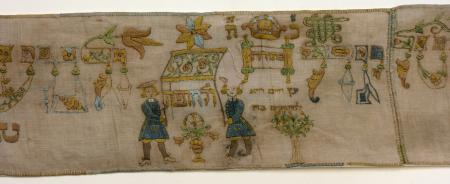Obj. ID: 39300
Sacred and Ritual Objects Wimple (Torah binder), Germany, 1719

The following description was prepared by William Gross:
The custom of the Wimpel or Torah Binder stretches back some 500 years at least in the world of classic Ashkenaz, the German speaking lands. The cloth which held the child at the time of his circumcision, almost always of linen, was cut into strips and sewn into a long textile. On this lengthy cloth was embroidered or painted a formulaic inscription, blessing the child and wishing that he grow up to "the Torah, the Chupah and good deeds". The beginnings of the custom were executed on linen cloth with silk embroidery. In the late 18th century the custom passed to painting on the textile with substantial illustration, although late examples of embroidered Wimpels do exist. Wimpels in the Gross Family Collection have their origin from Germany, Denmark, the Czech lands, Luxembourg and Alsace. The Wimpel served as a Torah Binder, being brought to the synagogue for use on the child's first birthday, his Bar Mitzvah and the Shabbat Chatan before his marriage.
THIS TORAH BINDER, A WIMPEL, IS A 18TH CENTURY VERSION OF A CUSTOM IN GERMAN SPEAKING COUNTRIES. EVIDENCE OF THE CUSTOM GOES BACK AT LEAST 500 YEARS. THE CLOTH THAT HELD THE BABY AT THE CIRCUMCISION WAS CUT, GENERALLY, INTO FOUR STRIPS, SEWN TOGETHER LENGTHWISE AND EMBROIDERED WITH A FAIRLY STANDARD FORMULA, USUALLY BY THE WOMEN OF THE HOUSEHOLD. THIS IS A PARTICULARLY FINE FULL EMBROIDERY, DEPICTING MEN HOLDING THE CHUPAH, A DOUBLE HEADED EAGLE, AND A DOUBLE TAILED LION, AMONG OTHER MOTIFS. THE DEPICTION OF THE DOUBLE HEADED EAGLE WITH THE HEART IS VERY SIMILAR TO THE IMPERIAL EAGLE OF THE BURGAU AREA AND IT IS PROBABLY THAT THE WIMPEL IS FROM THAT AREA. TO COMPLEMENT THE ILLUSTRATION OF THE TORAH, THE IMAGE OF A TREE IS USED, AS THE TORAH IS REFERRED TO AS THE "TREE OF LIFE". FOR A COMPARISON SEE #2 FROM THE "MAPPOT' CATALOGUE.
Name: Uri bar Yehudah Aryeh

















